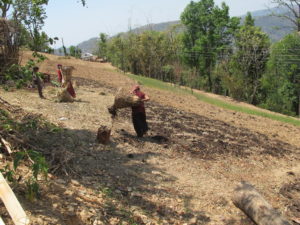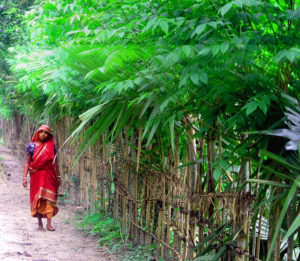
Marking International Day of Rural Women, Giulia Micheletti and Marlène Elias of Bioversity International discuss a framework for understanding how forest landscape restoration can promote gender equality.
It does so by safeguarding and advancing women’s land rights, encouraging their meaningful participation, and recognizing their expertise and priorities in restoration activities.
For many rural women, fulfilling everyday responsibilities such as agricultural production and home gardening, as well as collection of fodder, fuelwood, water and forest products have become more difficult due to environmental degradation. This adds to women’s heavy labor burdens, for example as they have to venture farther from home to gather these products.
Read more: Gender matters in Forest Landscape Restoration: A framework for design and evaluation
Yet, while the need to restore degraded lands and landscapes is pressing and gaining global attention, restoration initiatives often overlook rural women. As rural men typically have more public authority than women and are considered heads of their households, interventions that work with rural communities tend to favor them when it comes to choosing the areas and species to restore. In fact, gender inequality is an important but under-appreciated factor hindering restoration and the fair distribution of benefits from the process.
A new framework to promote socially just and equitable interventions in forest landscape restoration has been published by gender researchers from Bioversity International, the Center for International Forestry Research (CIFOR), and the World Agroforestry Center (ICRAF). Developed within the CGIAR Research Program on Forests, Trees and Agroforestry (FTA), the framework explains that restoration initiatives must consider how gender relations shape access to and control over land and its use, and how changes in land use that may result from restoration can disadvantage women if their rights to resources, priorities, and contributions of labour and knowledge are overlooked.
Read also: What do gender norms, innovation and trees have to do with each other?
Forest landscape restoration
Forest landscape restoration aims to regain the ecological integrity of deforested and degraded lands while simultaneously improving the wellbeing of forest-dependent communities. A critical issue in forest landscape restoration is safeguarding communities’ rights and access to their lands. On the one hand, community members with informal or insecure land rights can lose access to lands claimed under restoration initiatives. Adequate safeguards, grievance mechanisms and fair compensation must be in place to mitigate against such risks.
On the other hand, if carried out in an inclusive way, forest landscape restoration can be a vehicle for strengthening the rights of marginalized groups. In this way, it can help reduce inequalities based on gender or other factors of social differentiation.

Everyone’s needs count
Different members of communities inhabiting the areas to be restored often have different views on degradation, priorities for the type of vegetation or density to be restored, approaches used to restore them and the kinds of benefits they want to gain from the restored lands. For example, women and men from different socioeconomic, generational and ethnic groups may have distinct preferences for plants with medicinal or nutritional properties, or for those that provide mulch, food, fodder or income.
The local ecological knowledge and expertise of these different community members needs to be recognized, and their active participation in decisions fostered to ensure that they benefit equally from restoration initiatives.
Read also: Improving livelihoods, equity and forests through sustainable management of NTFPs
As women and men have different capacities (assets, time, knowledge and so on) to participate in these initiatives, different measures are needed to encourage their participation. For example, community meetings should be scheduled at times and in places that are easy for women to reach and allow them to complete their chores and take care of the children, and participate. Strengthening women’s capacities to voice their interests in public forums and challenging norms that limit their influence in community affairs are also required to foster their active participation.
Benefits from forest landscape restoration can range from income-generating opportunities, improved ecosystem services, enhanced knowledge and skills on farming or resource management techniques to security of tenure. Forest landscape restoration initiatives must recognize how gender differences affect the capacities of both women and men to access these benefits and place both genders on an equal playing field to improve the livelihoods of all.
By Giulia Micheletti and Marlène Elias, originally published at Bioversity International.
References
Basnett, B.S., Elias, M., Ihalainen, M. and Paez Valencia, A.M. 2017. Gender matters in Forest Landscape Restoration: A framework for design and evaluation, CIFOR Report, Center for International Forestry Research, Bogor.
Vira, B., Wildburger, C. and Mansourian, S. (Eds.) 2015. Forests, Trees and Landscapes for Food Security and Nutrition. A Global Assessment Report, IUFRO World Series 33, IUFRO, Vienna.
This work forms part of the CGIAR Research Program on Forests, Trees and Agroforestry, which is supported by the CGIAR Trust Fund.











